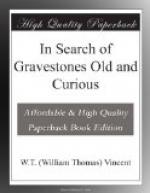[Footnote 17: The National Museum of Antiquities in Queen Street, Edinburgh, is unequalled by any other collection of British and Celtic remains. All these memorial stones are carefully catalogued, and have, moreover, the advantage of being described at length, with full illustration, in Professor Stuart’s copious work (previously mentioned) on “The Sculptured Stones of Scotland.”]
[Illustration: THE BRESSAY STONE FIG. 100.
LUNNASTING AND KILBAR STONES. FIG. 101.
OGAM AND RUNIC INSCRIPTIONS.]
The inscriptions upon such stones, when they are inscribed, are usually in Ogam or Runic characters. An example of the Ogam writing is shewn on the edges of the Bressay stone (Fig. 100), and also on the front side of the Lunnasting stone (Fig. 101a). The Ogam style was used by the ancient Irish and some other Celtic nations, and the “Ogams,” or letters, consist principally of lines, or groups of lines, deriving their signification from their position on a single stem, or chief line, over, under, or through which they are drawn, perpendicularly or obliquely. Curves rarely occur; but some are seen in the inscription on the Bressay stone, which has been thus interpreted by Dr. Graves, Bishop of Limerick: “Bentire, or the Son of the Druid, lies here.” “The Cross of Nordred’s daughter is here placed.” This stone was found by a labourer about 1851, while digging in a piece of waste ground near the ruinous church of Culbinsgarth at Bressay, Shetland. The design is said to be thoroughly Irish, and the inscription a mixture of Irish and Icelandic. The stone measures 4 ft. by 1 ft. 4-1/2 in. by 2 in. It is attributed to the ninth century.
The stone 101a is a slab of brownish sandstone, 44 in. by 13 in. by 11/2 in., from Lunnasting, also in Shetland. It was found five feet below the surface in 1876, and, having probably lain there for centuries, was in excellent preservation. The authorities, however, are unable to make a satisfactory translation. The cross or dagger is also of doubtful explanation; and Mr. Gilbert Goudie thinks it is a mere mason’s mark. It is, however, admitted on all hands that the stone is of Christian origin, and probably of the period just subsequent to the termination of the Roman rule in Britain. It has been suggested that most of these ancient gravestones were carved and set up by the Irish missionary monks not earlier than A.D. 580. The Ogam inscription on the Lumasting stone has been made by one expert to read:
EATTUICHEATTS MAHEADTTANNN
HCCFFSTFF NCDTONS.
A strange and inexplicable aggregation of consonants.




